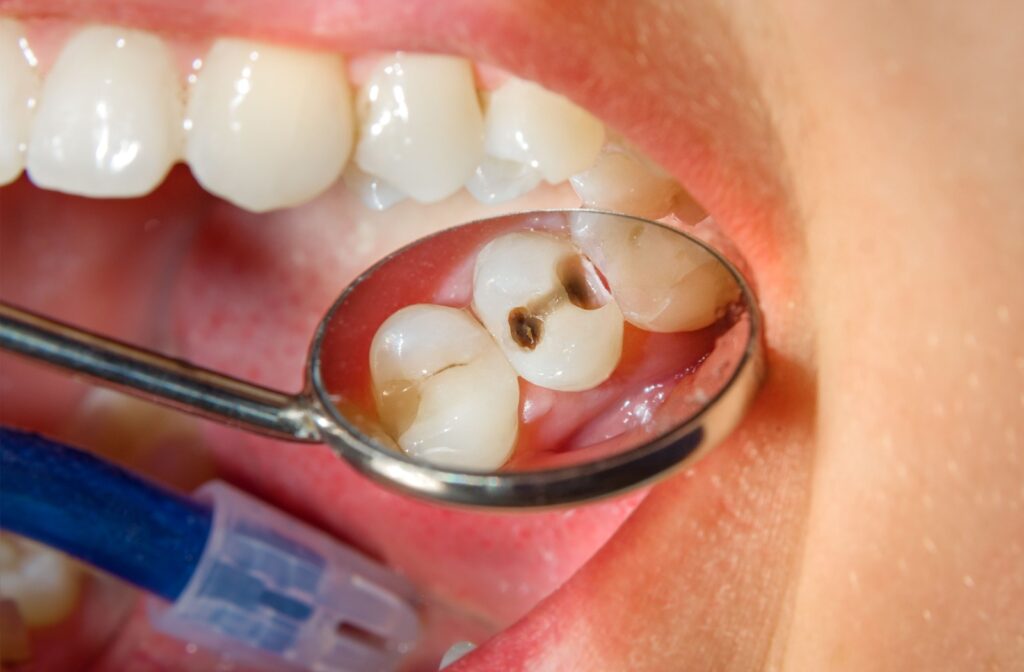Recognizing the early signs of tooth decay is crucial for protecting your smile and knowing when it is time to visit your dentist.
Cavities do not always look the same. At first, they may appear as faint white, chalky spots, but as the decay progresses, they can turn light brown, dark brown, or even black. In more advanced stages, you might notice a small hole or pit in your tooth.
While these changes can sometimes be visible, cavities often develop without visible signs, which is why regular dental exams, professional cleanings, and x-rays are so important. Dentists can spot early decay long before it causes discomfort or serious damage, making routine visits one of the best defences against tooth decay.
How to Tell If You Have a Cavity
Small cavities may not be noticeable at first. However, certain changes can indicate that decay is developing:
- White, chalky spots on the enamel
- Light brown, dark brown, or black marks
- Small pits or holes in a tooth
- Red or swollen gums near a specific tooth
Some signs are detectable only by a dental professional during an examination, highlighting the importance of regular checkups.
While not visible, other symptoms can include:
- Discomfort that occurs without any clear cause
- Tooth sensitivity to sweet, hot, or cold foods and drinks
- Discomfort when you bite down
- Persistent bad breath that does not go away after you brush
Distinguishing Cavities from Stains
Cavities often appear as distinct spots on individual teeth, whereas stains from coffee, tea, or food usually cover larger areas or multiple teeth. A dentist can detect subtle differences and determine whether a spot requires treatment.
What Happens If a Cavity Goes Untreated?
A small cavity can become a bigger problem if it is ignored. The decay can move through the outer layer of your tooth to the deeper layers. This progression can lead to more complex issues over time.
From Minor Discomfort to Major Problems
Untreated decay can lead to a larger hole in the tooth, a toothache, or even a dental infection or abscess, which may require a root canal to resolve. Early attention helps you avoid these more serious concerns. Addressing decay quickly is key to preserving your tooth structure.
When Discomfort Signals a Deeper Issue
If a cavity starts to hurt, it usually means the decay has reached the inner layer of the tooth, called the dentin, or the nerve in the centre. At this stage, professional dental work is necessary to fix the tooth. This discomfort is a clear signal that it is time to see your dentist.
Can You Stop a Cavity on Your Own?
Once a physical hole has formed in your tooth, it cannot heal by itself. However, if tooth decay is caught in the earliest stage (before a hole forms), you can take steps to stop its progress.
When decay is just a white spot of mineral loss, you can help your enamel repair itself. This process, called remineralization, is supported by good oral hygiene. Using products with fluoride toothpastes can also help strengthen the tooth surface.
If the decay has broken through the enamel to form a cavity, you will likely need a dentist to repair it.

How Your Dentist Can Help
Regular checkups are the most reliable way to spot cavities early. Your dentist has the tools and experience to find decay long before you might notice it yourself.
During an exam, your dentist will look for any visual signs of decay. Dental X-rays can also be used to see what is happening between your teeth or below the gumline, where cavities often hide.
If a cavity is found, treatment will depend on the extent of the decay. For small cavities, a tooth-coloured filling is a common solution. For more extensive decay, a dental crown or other restoration may be suggested to strengthen and protect the tooth.
Simple Steps for Cavity Prevention
Good habits are your first line of defence against tooth decay. A few simple changes to your daily routine can make a big difference in your long-term oral health. Consistency is the key to prevention.
At-Home Dental Care Habits
- Brush your teeth 2 times a day for 2 minutes with a fluoride toothpaste.
- Floss between your teeth and/or use a Waterpik once a day to remove plaque where a brush cannot reach.
- Consider a fluoride mouth rinse for an extra layer of protection.
Diet and Lifestyle Choices
- Limit sugary foods and drinks, especially between meals.
- Rinse your mouth with water after eating if you cannot brush right away.
- Chew sugar-free gum to help increase saliva flow, which naturally cleans your teeth.
Take Care of Your Oral Health Today
Staying informed about your oral health is an important part of your overall well-being. Regular examinations allow for the early detection and treatment of concerns like cavities.
If you have questions about your dental health, our team at Cooper Dental is here to provide the information you need. Contact us to schedule your next appointment.




